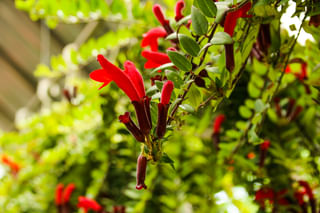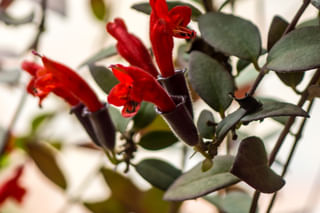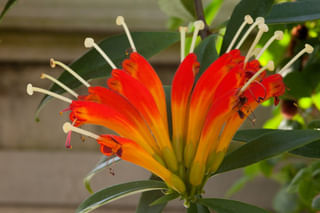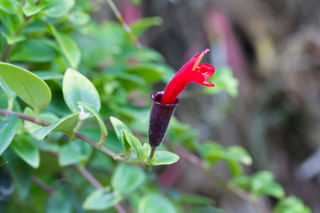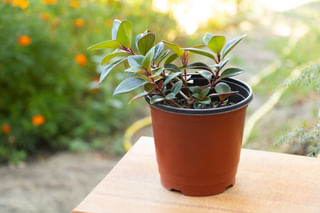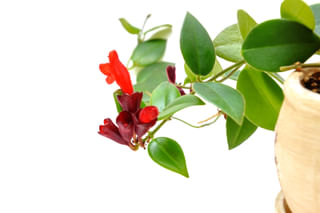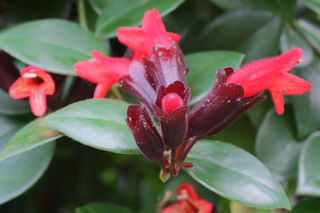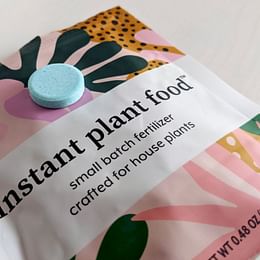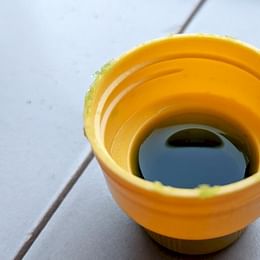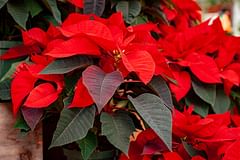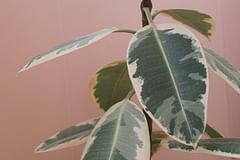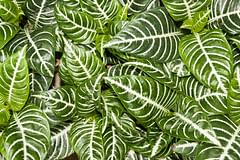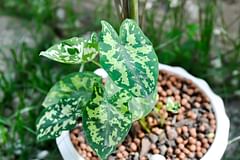How to care for an Aeschynanthus (Lipstick Plant)
Learn how to care for an Aeschynanthus (Lipstick Plant) with easy steps and the right tips. Follow this guide to get all the tools you need to help your plant grow and stay healthy in your home!
Have you been looking for a hanging plant, but you don't like the typical options like the Philodendron Mican or Golden Pothos? Then the Aeschynanthus, more commonly known as the Lipstick plant, might be exactly what you're looking for.
The Lipstick plant gets this nickname from the unusual-looking red flowers it grows: they look like lipstick. The combination of these bright red flowers and its deep green leaves make this plant pop and it will brighten up any room of your living space!
In this plant care guide, we're looking at these topics:
Caring for an Aeschynanthus, or Lipstick plant is easier than you might think! With just a few simple steps and the right tips, you can easily learn how to best care for your Lipstick plant. Follow these plant care tips to get all the tools you need to help your plant grow and stay healthy in your home.
Let's get started!
How often should I water my Lipstick plant?
The most important part of taking care of plants is watering them correctly, so let's look at what's ideal for a Lipstick plant.
The Lipstick plant loves to grow in soil that's slightly moist all the time. To help keep the soil slightly moist most of the time, you should water your plant when the top 2cm (1 inch) of the soil has dried up.
On average, you should water your Lipstick plant every 5-7 days but how long it takes for you depends on the humidity levels and temperature of your house. It could be sooner if you have a very dry house and lower humidity levels, but it could also take longer.
Before watering your plant
Before you water your plant, always make sure to check whether the top of the soil is dry. If it's still moist, wait a day or two and check the soil again. The Lipstick plant loves moist soil but doesn't do well if the soil is soggy. This will cause root rot and could kill your plant, so checking the soil before watering is important.
The best way to water this plant is to use a pot with a drainage hole and water the plant until the excess moisture starts to drip out of the drainage hole. Let the extra water drain for 5-10 minutes and the soil should have absorbed all the moisture your plant will need for the coming week or so.
How can I tell if my Lipstick Plant is getting too much or too little water?
It's very easy to water your plant too much or to forget about it for too long. So watering problems are very common for beginning plant parents. I had the same problem when I first started out. To find out if your Lipstick Plant is getting too much or too little water, look for the following signs:
Too much water:
- Yellowing leaves: If the leaves start turning yellow, it might be a sign of overwatering.
- Soggy soil: Consistently wet or soggy soil can lead to root rot.
- Wilting: Overwatered plants can wilt due to root damage, so they'll look underwatered.
Too little water:
- Dry soil: If the top 2cm (1 inch) of soil is dry, it’s time to water.
- Wilting: The plant may wilt if it’s not getting enough water.
- Brown leaf tips: Dry, crispy leaf tips can indicate underwatering.
When you see any of these signs, make sure to either let the plant dry out a little, or water it a little more often. I've found that creating reminders in your calendar work quite well when you forget to water your plants.
What kind of light does an Aeschynanthus need?
Watering is the most important part of taking care of your Lipstick plant to keep it healthy long-term. However, if you want your plant to grow larger, grow its bright flowers, and look better, you'll need to give it the right amount of sunlight.
The right amount of sunlight is a bright spot in your house when your plant gets filtered, or indirect, sunlight. The brighter the spot, the more flowers your plant will grow.
Too much sunlight
If you accidentally give your plant too much sunlight, you risk scorching its leaves. This usually only happens when you expose your Aeschynanthus to direct sunlight in the afternoon during the summer. Some direct sunlight in the morning or during the fall and winter is no problem, as this sunlight isn't strong enough and not warm enough to burn your plant's leaves.
Too little sunlight
If you've given your plant too little sunlight, when it's placed in a spot where it doesn't get enough sunlight, you'll notice that your plant doesn't grow much. It won't grow many new leaves, it won't grow any new flowers, and some of the leaves might start to fall off. If you notice this, make sure to move your plant to a brighter spot in your house.
What temperature range is ideal for an Aeschynanthus?
The Lipstick plant is a plant that grows in the tropical regions of Southeast Asia, so it's used to high temperatures and high humidity. Luckily, most plants are chosen as houseplants, because the growing conditions of average houses are great for their growth.
The Aeschynanthus prefers temperatures between 18-24 Celsius (65 F- 75 F). It can tolerate temperatures slightly under that as well, but once the temperature drops below 10 Celsius (50 F) it will damage your Lipstick plant.
It's also important to make sure you don't expose your plant to extreme temperature changes throughout the day. So make sure to keep it away from cold drafts and heat vents. These changes could put your plant in shock, which puts your plant at risk of dying.
What is the ideal humidity range for an Aeschynanthus?
Along with the temperature, also make sure that your Lipstick plant is getting plenty of humidity. Luckily, most houses should already have enough humidity to keep your Lipstick plant happy. The ideal humidity range is anywhere from 50-70%. Your house will likely already have humidity levels around 50%, so you might not have to do anything to help your plant.
If your house is particularly dry, you can increase the humidity by placing your plant on a pebble tray with water, misting it every few days, and placing plants closer together. By placing multiple plants closer together, they'll create a micro-greenhouse around them with higher humidity.
When you're trying the raise the humidity around your plant by misting it, make sure to do this during the early morning, as this reduces the risk of fungal problems.
What is the best soil mixture for growing an Aeschynanthus?
In the first section, about watering your lipstick plant, we've seen that the plant enjoys growing in soil that's moist most of the time. Soil that's moist most of the time tends to compact over time, so we'll need to give your plant a soil mix that can help it stay healthy for a long time.
The ideal soil mixture for your Lipstick plant is light and airy, has excellent drainage, and stays moist for several days. This sounds complicated, but there are several things you can mix in with your potting mix to give your plant the perfect soil mixture.
Creating the perfect mix
To get the ideal soil mix, you'll need to mix 1/2 general potting mix, 1/4 sphagnum moss, and 1/4 perlite or sand. Let's see what each of these ingredients does to help your plant thrive.
Potting soil helps to retain moisture, absorb fertilizer to feed your plant, and provide the needed nutrients for your plant to thrive. Potting mix is good at retaining moisture, which is why we'll need to mix it with something to improve drainage.
The sphagnum moss is a great ingredient for the soil mixture because it provides 2 things: structure and water retention. As we discovered a minute ago, moist soil tends to compact over time. The sphagnum moss helps to prevent this compacting by adding lots of layers and air into the soil. This keeps the keep the soil light and airy.
Sand or perlite are champions when it comes to improving the drainage of your soil mixture. These ingredients don't hold onto very much water and let most of it drain to the bottom of the pot. These ingredients are essential to helping you prevent root rot with your Lipstick plant.
What type of fertilizer should I use on my Lipstick plant?
Flowering plants, like the Lipstick plant, use a lot of energy to grow their flowers. Your Aeschynanthus gets most of this energy from the soil, you can help your plant grow a little more quickly and stay healthy during the growing season by fertilizing it.
There are several ways to fertilize your plant, like applying a slow-release fertilizer at the beginning of spring and the beginning of summer. However, my favorite way to fertilize houseplants is by using a liquid fertilizer.
Applying liquid fertilizer
To use liquid fertilizer for your lipstick plant, make sure to dilute it with water before you apply it. You can add this fertilizer to the water you use to water your plants, which is a convenient and time-saving way to feed your plants. You should fertilize it like this once per month during the spring and summer.
During the fall and winter, when your plant isn't growing very quickly, you should not fertilize your Lipstick plant at all, because this could put your plant at risk of overfertilizing. Overfertilizing causes the burning of your plant's roots and could lead to your plant dying.
When and how do I need to prune back my Lipstick Plant?
Pruning is an important part of keeping your plant looking great for many years. The best time to prune your Lipstick plant is right after the flowers have stopped blooming. At this time, you should prune away any dead or dying flowers to help give some energy back to the plant.
By pruning your plant with a pair of sharp scissors, you are not just making your Aeschynanthus look better, but you also help it to grow more flowers and you're reducing the risk of attracting pests on your plant.
By pruning any dead or dying flowers, your plant no longer has to put energy into growing those flowers and instead focus on growing new flowers. This will help to keep your lipstick plant looking lush and healthy for many years.
How often should you repot an Aeschynanthus?
Repotting a plant is one of my favorite parts of taking care of plants because you get to celebrate your hard work with a plant. You've taken great care of your plant, it has grown quite a bit over the past 1-2 years, and now it needs more space. I see it as a compliment for my plant care skills!
On average, you should repot the Lipstick plant once per year in the first 2 years and after that, you can repot it every 2 years. You'll know it's time to repot your Aeschynanthus when it has outgrown its current pot.
You can often recognize the signs your plant shows you when it has outgrown its current pot: It suddenly stops growing (in the spring and summer) and the roots start to circle the bottom of the pot. If you see these signs, it's time to repot your plant.
How do I repot my Lipstick plant?
To start repotting your Lipstick plant, make sure to mix up some fresh soil with perlite and sphagnum moss, and find a pot that's one size larger than the current pot. This new pot should be around 2 cm (1 inch) larger on both sides of the old pot. Fill the new pot with a fresh layer of soil, 2-5 cm (1-2 inches) deep.
When removing the plant from the current pot, remove some of the loose soil around the roots and place your plant in its new pot. Add fresh soil around the roots and fill in any air gaps in the soil by sticking a chopstick or another stick in the soil. These air gaps hold onto moisture and could cause root rot and fungal infections.
After you've repotted your plant, water it thoroughly and make sure to let the excess moisture drain from the pot for about 10 minutes.
What kind of pot is best for my Lipstick Plant?
Choosing the right pot for your Lipstick plant is so important. The right pot not only has space for the roots to grow but also ensures proper drainage to prevent water-related issues. For your Lipstick Plant, the best pot is one that has drainage holes at the bottom. Here's why and what to consider:
Drainage holes are important
Drainage holes are key for plant health. They help prevent overwatering by letting extra water escape, so the soil doesn't get waterlogged and cause root rot. They also boost air circulation around the roots, keeping your plants growing strong.
Pot material
Terracotta pots are great for Lipstick Plants because they're porous and let the plant breathe better, but they're a bit heavier than plastic ones. On the flip side, plastic pots are lightweight and keep moisture longer, which is great if the plant is in a drier spot.
Size and Shape:
When picking a pot, go for one that's just a bit bigger than the current root ball so your plant has room to grow. A regular round pot works great, just make sure it's deep enough for the roots.
Tips for hanging pots:
For secure hanging, go for strong hooks and chains to make sure the pot stays put. If you're using a terracotta pot, think about picking smaller ones if weight is an issue.
How do I propagate a Lipstick plant?
You've taken excellent care of your Lipstick plant for a year or so and your plant is getting a little too big for its space. If it's not ready to be repotted, then it might be time to prune it a little to make it fit the space again. The stems you cut off, however, aren't trash. You can propagate these in the spring and summer and grow a whole new plant.
Let's see how to propagate these plants!
Steps to propagating a Aeschynanthus
When you're pruning your plant, look for a healthy stem that has recently been growing but doesn't have any flowers on it yet. These stems can very likely succeed as propagated stem cuttings. When you cut this stem, make sure to use clean, sharp scissors for minimal damage to the plant and the cutting. Clean scissors or shears also help prevent the spread of diseases or pests.
Remove most of the bottom leaves of the stem, because you'll need to help your cutting to preserve as much energy as possible.
Prepare a pot with some vermiculite and perlite. This combination of ingredients will provide your cutting with a moist, but sterile growing environment. If you were to put the cutting into the soil right away, you could run the risk that your cutting gets infected with pests. Young cuttings are a very attractive target for many pests and diseases.
Over the next few weeks, keep the perlite and vermiculite mixture lightly moist and keep an eye out for any root growth. After 2-4 weeks, you should start to see some roots growing. Wait a few more weeks before moving your cutting to a pot with the soil mixture from earlier. This is where it will grow permanently and you'll have successfully propagated your Lipstick plant.
Should I clean the leaves of my Lipstick Plant?
Keeping your Lipstick Plant's leaves clean is a great way to keep it healthy. Dust can pile up and block sunlight, messing with photosynthesis. Plus, regular cleaning helps you catch and remove pests before they become a problem.
How to clean the leaves:
- Use a soft cloth: Dampen a soft cloth or sponge with lukewarm water.
- Gently wipe: Carefully wipe each leaf, supporting the underside with your hand to avoid damage.
- Avoid harsh chemicals: Stick to water or a mild soap solution if you need to.
- Regular maintenance: Aim to clean the leaves every month or so, especially if you notice dust buildup.
Cleaning the leaves of your plants is so easy to forget, but can have such a big impact. So again, if you tend to forget to do this (like me), add reminders in your calendar. It's worth the effort!
What are common problems for a Lipstick plant?
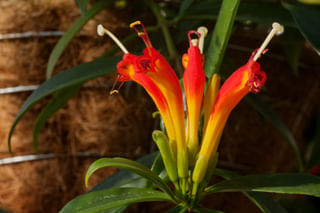
Pests
Aphids are tiny pests that can damage lipstick plants. To get rid of them, use a special oil or spray the plant with water. Mealybugs are soft-bodied insects that suck on lipstick plants. To get rid of them, use an insecticidal soap or alcohol to remove the pests. Aphids and mealybugs can lead to yellowing leaves and stunted growth.
Additionally, these pests can excrete a sticky substance known as honeydew, which may encourage the growth of sooty mold, further hurting the plant's ability to photosynthesize and thrive.
Spider mites are tiny arachnids that can cause discoloration and yellowing of lipstick plant leaves. They can be treated with neem oil or insecticidal soap.
Overwatering
Another big issue with the Lipstick plant is overwatering. This can lead to root rot, wilting, and even death if not addressed. To avoid this problem, make sure you're only watering your plant when the top inch of soil is dry.
Fungal diseases
If you're misting your Lipstick plant during the day and the leaves stay wet for too long, the plant can be prone to fungal problems and leaf spot. It's important to only mist your plant in the early morning and make sure not to get the leaves overly wet.
If your Lipstick plant gets leaf spots or fungal issues, act fast! Snip off affected leaves with clean scissors to stop the spread. Keep leaves dry by avoiding overhead watering and improve air circulation to lower the humidity. Use a houseplant fungicide as directed and let the top inch of soil dry out before watering again. Keep an eye on your plant so you can catch problems early for a healthy recovery.
What signs should I look for that my Lipstick Plant is not healthy?
If you're wondering what it looks like when your plant isn't doing well, you'll want to look for these symptoms.
Look for yellowing leaves, which might mean overwatering, poor drainage, or nutrient deficiencies. Check the soil, adjust watering, and maybe add some fertilizer. If you notice wilting or drooping, it could be underwatering or root rot from too much water. Make sure you water consistently and check for root health.
Keep an eye out for leaf drop due to sudden changes in temperature or light. Try to keep conditions stable and avoid moving the plant too much. Brown tips or edges on leaves could mean low humidity or too much fertilizer, so increase humidity and cut back on feeding.
If your plant has stopped growing, it may need more light or nutrients, but could also be rootbound. Watch for pests like insects or sticky residue, and treat with insecticidal soap or neem oil if needed.
Winter & summer care for a Lipstick Plant
Changing your care routine for your Lipstick Plant in the different seasons is important for keeping it healthy during the whole year. During the seasons, the temperature, light, and humidity changes, which can really impact its growth.
Here's how you take care of your plant in the summer and winter!
Summer
- Watering: Water more often since the plant dries out quicker with the heat and more light.
- Light: Make sure it gets bright, indirect light. You might need to move it a bit to avoid harsh direct sunlight.
- Humidity: Keep the humidity high by misting or using a humidity tray, as indoor air can dry out with the AC on.
- Fertilization: Feed your Lipstick Plant every 4 to 6 weeks using a balanced, water-soluble fertilizer, diluted to half strength to avoid overdoing it.
Winter
- Watering: Water less often because the plant's growth slows and it needs less water.
- Light: Make sure it still gets enough light since there is less natural sunlight. You might need to move it closer to a window or use a grow light.
- Temperature: Keep it away from cold drafts and ensure the room stays above 10 Celsius (50 F).
- Fertilization: As growth slows and your plant goes into its dormancy period, stop fertilizing altogether.
- Humidity: Indoor heating can really dry out the air. To increase humidity, try using a humidifier or place a water tray near the plant.
As you can see, your plant needs different care during the year. You can easily find out if you need to start watering your plant more or less by checking if the soil is still moist more often. You'll notice it dries out more quickly in the summer and takes longer in the winter.
Is the Lipstick plant safe for pets?
The Lipstick plant is a great choice for those who have pets and small children because this plant is non-toxic and completely safe!
Conclusion
The lipstick plant is a great choice for those who want to bring some greenery into their home without worrying about pet or child safety. With proper care, you can maintain the beautiful foliage and bright flowers of this species. Watering should be done when the top inch of soil is dry, while fertilizer should only be applied once per month during the growing season.
The lipstick plant prefers indirect sunlight, which it needs to grow its beautiful flowers. Make sure that your lipstick plant's soil has good drainage and add perlite and sphagnum moss to increase aeration and humidity levels around your plants. Lastly, rest assured knowing that lipstick plants are non-toxic and completely safe for pets (and small children).
Thank you for reading this post! I hope it helps you to keep your plants healthy and beautiful! If you're looking for more guides on specific plants, you can always request a plant guide to get a guide for the plant you have trouble with.
Test your plant care knowledge
Quiz completed!
Want to learn more? Sign up for my newsletter to receive free tips in your inbox!
Sign up now!